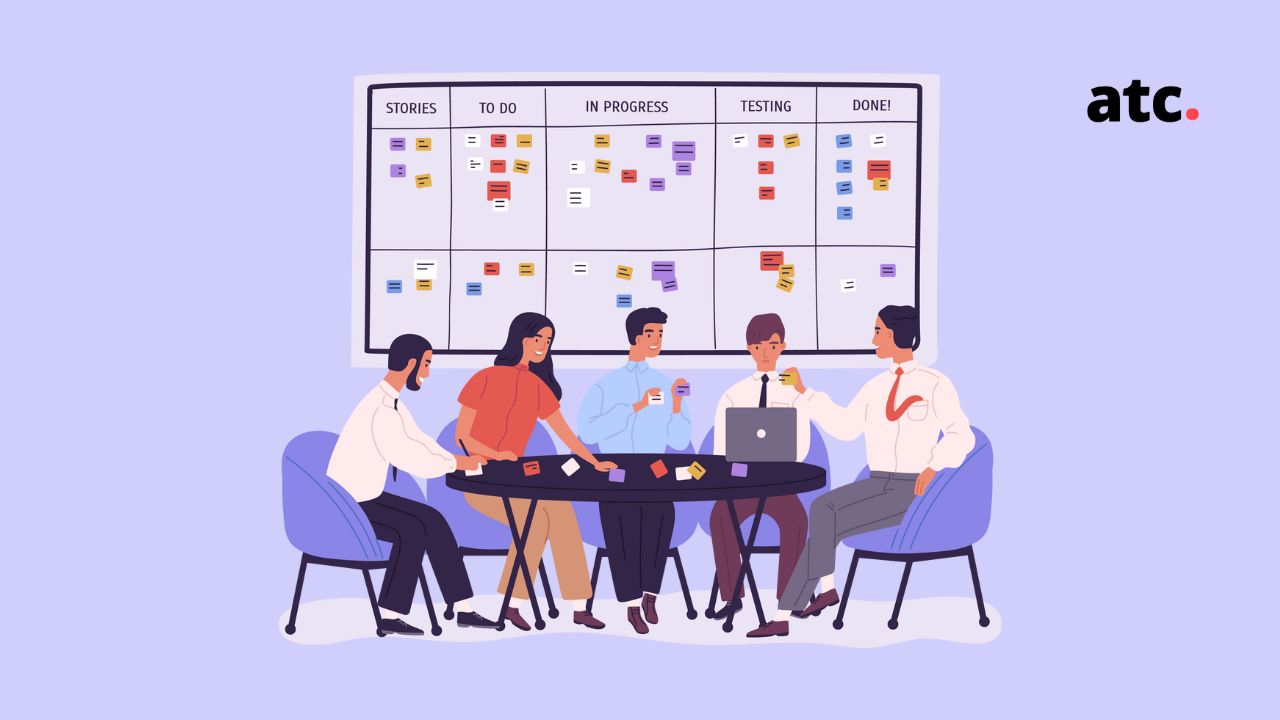Subscribe to the blog
For teams to successfully work together, they require a playbook that guides them on best practices. As a project management methodology, Scrum has many advocates. It is reportedly the most commonly used Agile methodology under which there are guidelines and solutions for meetings, tools, and roles that work together and help teams structure and manage their work.
Scrum takes a staggered as well as an iterative approach. It breaks one big task into several small ones, which are organized around staggered meetings, ships the product or the updates, and then feeds back customer response to the team to work on the next set of upgrades.
Scrum is one of the most demanded tech skills, next only to project management. So what does the Scrum protocol look like in action? What is a Scrum team in action?
What is Scrum?
The Scrum framework aims to minimize uncertainties and establish controls at different points in a project's life cycle. So, if you have a new product to be shipped in a month, the delivery would be done on an iterative, incremental basis. This means that the developers will work on releasing or launching the product in stages.
To achieve this, they will conduct daily Scrum meetings, which are essentially daily check-ins to see if everyone on the team is on track with their mini-goals, which will gradually lead to the umbrella goal. The framework of a sprint guides the accomplishment of the goal at each stage. A sprint is usually described as “a short, time-boxed period when a Scrum team works to complete a set amount of work.”
As the name suggests, Scrum breaks down the task into several shorter ones, so that it feels like running several short sprints rather than one big marathon. Scrum engages everyone on your team—even those in other departments and those who need to be looped in on the progress—whose efforts, skills, and expertise will collectively lead to accomplishing the task.
Scrum team members work like a well-oiled machine, built on the pillars of transparency, inspection, and adaptation.
What is a Scrum Team?
The Scrum team structure comprises all the people collaborating and working together on the project. The overall project is divided into and broken down into smaller tasks and responsibilities. These responsibilities are then distributed among the Scrum team members.
You will usually find the following three roles in a Scrum team:
- The Scrum Master
- The Product Owner
- Development team members
There may be only one Scrum Master and one Product Owner, but multiple Scrum team members make up the development team, i.e., the engineers working on the product.
The size of the teams isn't too large in Scrum settings. It's advised not to have more than 10 Scrum team members. It's also easier to abide by the meetings framework, goals, and the awareness of who's responsible for what part of the job.
On the one hand, Scrum does not impose any rigid structure on the framework because of how varied and dynamic the needs of a project can be. However, it does suggest some Scrum team roles to keep the machine running.
Scrum Team Roles
As mentioned before, a Scrum team comprises three roles: the Scrum Master, the Product Owner, and the development team members. Now let's look at these roles in detail.
Scrum Master
As the name suggests, a Scrum Master is the team member who is in charge of the effective execution of the Scrum operation. They are the one who keeps the team aligned and on the planned path regarding deadlines, communication, and problem-solving. They plan meetings and lead the Scrum, gathering updates and brainstorming solutions for team challenges. They work out any obstacles that the team might be facing. Scrum Masters might work in a different role within an organization, so they will try to transfer Scrum concepts to the rest of organizational work.
A Scrum Master is often referred to as the “servant leader” in a Scrum team structure. They exist to serve, but they serve best by leading. They're truly in a unique position.
Keep in mind that the Scrum Master's role is more supervisory than proactive. For example, they will ensure that Scrum meetings are happening daily but not run the meeting by themselves.
Roles and Responsibilities:
- They help everyone understand the Scrum theory and apply it in practice.
- They lead the Scrum efforts to ensure that the entire team is performing efficiently.
- They spearhead daily Scrum meetings or standups.
- They play a role in establishing milestones and timelines.
- They conduct work reviews to see what went well, what could be improved, and to identify wasteful practices that can be eliminated from the cycle.
- They look over each team member and their performance and engagement through one-on-one meetings.
- They are the team's representative for the stakeholders outside of the team.
- They also remove any impediments or hurdles in the team's progress.
Product Owner
The Product Owner is responsible for maximizing the product's value that the Scrum Team is working on. When it comes to the value generated by the Scrum team, it's the Product Owner's responsibility. Does the team understand the commercial needs of the product? Is the team in touch with the customer expectations? Is it aware of the market trends? Can team members direct their efforts toward the collective goal?
Product Owners usually maintain close contact with the team of developers, guiding them on the product vision and with external stakeholders, such as the product manager in the organization. They are the connecting link between the people who create and those who ideate.
This is a crucial role in any Scrum team because the product owner actively studies customer needs and understands the development process. This type of person is well equipped to guide developers to continuously evolve without burning out. They can also mediate and balance out everyone’s needs in the team as well as the organization.
Roles and Responsibilities:
Product Owners usually take up the following responsibilities:
- They sort the product backlog by creating an order of priority.
- They are visionaries, in the sense that they set product goals for the team.
- They act as the team's link with external stakeholders of the development process.
- They monitor and then communicate the market's needs to other stakeholders and the team.
- They make sure the team is hitting product goals through close monitoring and evaluation of progress.
Check out: Skills you need to be a Great Product Owner
Development Team
The Scrum team members involved in the hands-on task of creating the product comprise the development team. You might think, at first glance, that this is just the team of coders and engineers. But that's a myth. The development team includes anyone and everyone involved in shipping out the product. These include software engineers, coders, designers, writers, analysis, and other experts as per the requirements of the product. This team works collaboratively to chalk out goals and action plans to achieve those goals.
It should be noted that different development team members will have different responsibilities. For example, a UX designer cannot interchangeably do the work of hm the front-end engineer or a copywriter cannot do the work of the marketer in the Scrum team. The product and goals will determine the individual responsibilities. The project also defines the membership in a Scrum team.
Usually, the development team is responsible for the following.
- Aid in sprint planning
- Deliver the work done during the sprint
- Bring their respective expertise for product enhancement and improvement
- Customer feedback integration and iterations
- Testing of products and other forms of quality assurance
- Coordinating with other members of the group and attending daily Scrum or standups
Scrum Team Roles and Job Titles: Let's settle the debate
The three Scrum team roles described are the recommended roles in the Scrum framework. These roles are meant to facilitate the Scrum implementation in the team. However, these should not be confused with the job titles. These aren't new roles that you'll need to fill or find suitable candidates for.
Your existing employees can perform these roles based on their suitability for the job at hand. Someone with managerial prowess and supervisory instincts will be able to fit into the role of the Scrum Master very well.
It’s easy to confuse these roles and job titles because the former can seem to be overlapping at times. Let's look at some such scenarios.
One of the most frequent confusions is whether a Scrum Master is the same as a project manager. It's easy to see why that confusion arises. Both the roles are heavily managerial and supervisory and both involve the dominant task of keeping the project progress on track.
But remember that a Scrum Master keeps a Scrum team on track with their goals while abiding by Scrum principles for the task at hand. On the other hand, the project manager is largely concerned with the big picture. For example, budgetary considerations fall under their purview, too. So they need to ensure that the Scrum team members don't overuse or waste resources. While Scrum Masters are also concerned with efficiency, they may not have control over tangible financials.
Does this mean a Scrum Master is essentially a project manager? Not necessarily. A Scrum Master’s role is not limited to that of a project manager, and the Scrum principles guide their work, making it a unique role. Scrum is, after all, a kind of project management role.
Another frequently asked question is whether job titles and Scrum roles are the same. Like we saw in the example above, job titles and Scrum roles can overlap, but they're hardly ever the same thing.
Your job title can refer to you as a copywriter, but as part of the Scrum team, you will be called a development team member. That does not mean you're not a copywriter in the organization, but Scrum roles are not always reflective of your overall role in the whole organization. It's like a role-play that employees do to accomplish a task.
To that end, when finalizing the people for the different roles in your Scrum team, you should match “skills” with the Scrum titles.
For example, an employee who brings a unique set of skills to the table should be part of the development team. It's even better if they're enthusiastic about incorporating customer feedback and revisiting their work for iterative improvements. The defining factor should be their willingness and the skills required to deliver value to the end-user.
If there's an employee who exhibits expertise in navigating different stakeholder interactions, such as customers, leadership team, the business team, and the knowledge workers, while also understanding the skill-based demands of the project, they would be a suitable candidate for the product owner role. A master negotiator is precisely who you need in order to align everyone's efforts for team success.
Finally, for the role of a Scrum Master, you should look at someone with natural leadership talent; someone who can be a great coach, teacher, and facilitator is best suited for this role. A “people person” would ideally be able to keep everything together.
This brings us to another question: Can a product owner also be the Scrum Master?
Now that you've understood the role of each member, you will appreciate that we need someone who is not too close to the project to keep the machinery well-oiled.
The product owner is too deep in the trenches of the project. They know customer needs, balance cost, and delivery details and constantly fight timelines. Their hands are full as they constantly have their ear to the ground, learning and communicating customer needs to their teams.
So, in theory, it might seem doable to have a single person take up both the roles, but in practice, it's best for everyone's efficiency that two different individuals handle the two roles. The mindset for both roles is disparate.
How do Scrum Roles work together?
Together, all three roles of the Scrum Master, product owner, and developers make up a Scrum team. However, to a large extent, everyone does a little bit of everything. That's the great part about a Scrum team—everyone shares collective accountability. Very often, Scrum teams are cross-functional, which means that the members come from varied backgrounds and skills, so they can self-manage.
The size of the Scrum team also ensures that a) significant strides are made in the project within each Sprint and b) communication takes place swiftly.
To summarize, Scrum involves a Scrum Master facilitating an environment where the product owner can organize a problem into a Product Backlog and then assign it to the Scrum team. They then work and deliver in a Sprint. The deliverables from the Sprint are assessed, and feedback is shared. We use all this information and experience and head into the next Sprint.
Conclusion
Scrum is an easy and lightweight framework that any industry can adopt to deliver value to their customer. Agile teams work collaboratively to achieve their goals, and Scrum is an effective framework for them to do this.
Scrum is the most widely-used framework based on agile values and principles to optimize the value of the delivered products. Understanding the roles in a Scrum team structure can be crucial in bringing clarity to these processes. This is where Scrum certifications can help acquire required skills and open up a universe of career opportunities for those with project management skills that come in handy to establish and manage a Scrum environment.




